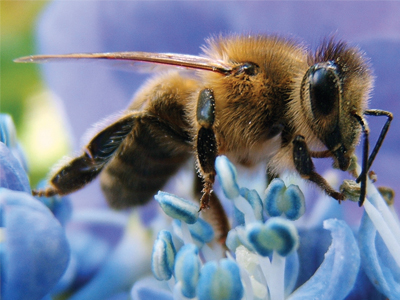MCP: We shall know thine enemy, honey bee
Varroa destructor is appropriately named, given the havoc it wreaks on colonies of western honey bees. Since it first arrived in Florida in the 1980s, the parasitic mite has pushed bee colonies across North America to ruin, and it is believed to be the most significant contributor to the recent spike in colony deaths in the United States and Canada. Despite the scope of the mite’s damage, however, surprisingly little is known about its inner molecular workings.
 A western honey bee rests on a flower. RICKS/WIKIMEDIA COMMONS
A western honey bee rests on a flower. RICKS/WIKIMEDIA COMMONS
As a first step in ultimately combating this bee-barian, researchers in the lab of Leonard Foster at the University of British Columbia in Canada have published a protein atlas in Molecular & Cellular Proteomics that details 1,433 differentially expressed proteins across the various developmental stages of V. destructor.
“One thing that a lot of people who are studying model systems or human systems don’t really appreciate is that when you move outside of those model systems and try to understand something at a molecular level about an organism without that huge body of knowledge that has been built over the years in that particular organism, you really don’t have any idea where to start,” Foster said. With this in mind, Foster and colleagues, including graduate student Alison McAfee, set out to create a document of the entire proteome that the male and female mites might produce throughout their life cycles.
“It’s a tool that other researchers can use to come up with their own questions about Varroa biology,” said McAfee, whose research focuses on the defense mechanisms bees mount against the mites.
In addition to quantifying the mites’ proteins, the researchers found that males and females expressed proteins involved in chromatin remodeling differently.
“Very little is known about the sex determination system in Varroa,” McAfee said. “Part of what that might be pointing to is the mites exposing different parts of the DNA to express more sex-specific proteins.”
The harm that V. destructor inflicts on honey bees is multifold; in addition to feasting on the bees’ blood and leaving open wounds ripe for infection, the mites are vectors for the deformed wing virus, which cripples wing growth in developing honey-bee pupae.
The scope of damage from mites is a consequence of abrupt introductions — the longer a host and parasite have coexisted and coevolved, the more harmonious, if still exploitative, their relationship will be.
Such is the case with V. destructor and its original host, the Asian honey bee, which have had millions of years to get to know one another. However, V. destructor and its viruses have just barely begun to make evolutionary introductions with honey bees, giving their new hosts few genetic weapons to fight them off.
According to Foster, Varroa’s use of odorant-binding proteins is likely key to their predatory interactions.
“Varroa have to be able to detect bees of certain ages, and this has to depend on odors,” he said. “At some point, we will want to try to define the molecular mechanism that is underlying that interaction, and knowing which proteins are expressed in which stages in the Varroa will be important for that eventual understanding.”
Enjoy reading ASBMB Today?
Become a member to receive the print edition four times a year and the digital edition monthly.
Learn moreGet the latest from ASBMB Today
Enter your email address, and we’ll send you a weekly email with recent articles, interviews and more.
Latest in Science
Science highlights or most popular articles

Building the blueprint to block HIV
Wesley Sundquist will present his work on the HIV capsid and revolutionary drug, Lenacapavir, at the ASBMB Annual Meeting, March 7–10, in Maryland.

Gut microbes hijack cancer pathway in high-fat diets
Researchers at the Feinstein Institutes for Medical Research found that a high-fat diet increases ammonia-producing bacteria in the gut microbiome of mice, which in turn disrupts TGF-β signaling and promotes colorectal cancer.

Mapping fentanyl’s cellular footprint
Using a new imaging method, researchers at State University of New York at Buffalo traced fentanyl’s effects inside brain immune cells, revealing how the drug alters lipid droplets, pointing to new paths for addiction diagnostics.

Designing life’s building blocks with AI
Tanja Kortemme, a professor at the University of California, San Francisco, will discuss her research using computational biology to engineer proteins at the 2026 ASBMB Annual Meeting.

Cholesterol as a novel biomarker for Fragile X syndrome
Researchers in Quebec identified lower levels of a brain cholesterol metabolite, 24-hydroxycholesterol, in patients with fragile X syndrome, a finding that could provide a simple blood-based biomarker for understanding and managing the condition.

How lipid metabolism shapes sperm development
Researchers at Hokkaido University identify the enzyme behind a key lipid in sperm development. The findings reveal how seminolipids shape sperm formation and may inform future diagnostics and treatments for male infertility.

